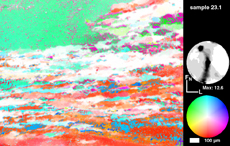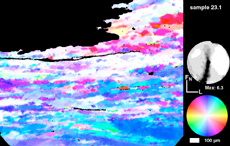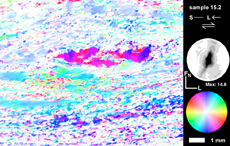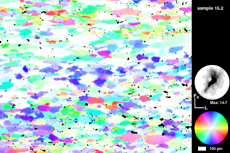5.4
ORIENTATION IMAGES OF NATURALLY DEFORMED ROCKS
top / contents / section 5 / pages -- 5.1 -- 5.2 -- 5.3 -- 5.4 -- 5.5 -- 5.6
Quartz veins from the Tonale fault
(Michael Stipp)

The c-axis-orientation images are sheared quartz veins from the Tonale fault, a major segment of the Periadriatic fault system. The Tonale fault cuts the contact aureole of the Adamello pluton, i. e. it is contemporaneous with the thermal event, resulting in a temperature gradient from about 700 °C to 280 °C in the syndeformational mylonites. The deformed lithologies, which contain the quartz veins used for microstructural analysis, consist of a series of metasediments yielding critical mineral assemblages for p,T-estimates. For quartz, the complete range of dynamic recrystallization (bulging, subgrain rotation and grain boundary migration recrystallization) from the brittle-ductile transition up to nearly melting conditions is developed. With increasing metamorphic temperature, the samples display a strong increase in the recrystallized grain size from 5 µm up to more than 5 mm. Three samples from the subgrain rotation and grain boundary migration recrystallization regimes are shown.
MS23-1 (about 450°C): Subgrain rotation recrystallization: large ribbon grains (masked in the CIP-image) surrounded by recrystallized grains which can be described as core and mantle structures (visible only at lower magnifications); the recrystallized grains form an oblique fabric with respect to the main foliation and have a prolate shape anisotropy. The c-axis pattern shows an oblique single girdle for the recrystallized grains and a single crystal maximum for the unmasked ribbon grain.
MS15-2 (about 500°C): Subgrain rotation recrystallization: ribbon grains are almost totally consumed by progressive subgrain rotation, and to a small extent by grain boundary migration; the recrystallized grains form an oblique fabric with respect to the main foliation and the prolate shape anisotropy is increased in comparison to sample MS23-1. The c-axis pattern shows a strong maximum in the Y-direction of the pole figure indicating dominant prism <a> slip; a weak crossed girdle (relict of lower temperature deformation?) can also be observed.
MS66-3 (about 650°C): Grain boundary migration recrystallization: completely dynamically recrystallized sample with "island grains" and a "dissection" microstructure (masked zones contain cordierite, sillimanite, plagioclase, biotite); chess-board extinction indicating high temperature deformation at the transition from a- to b-quartz is also visible. The c-axis pattern shows a first maximum parallel to Y, comparable to that one of sample MS15-2, and a second maximum close to the stretching lineation (X) which can probably be interpreted as combined prism <a> and prism <c> slip.
Stipp, M., PhD thesis, Dept. of Geosciences, Basel University (http://www.unibas.ch/earth/)


